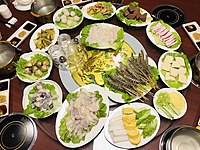Chaoshan
This article may require copy editing for grammar, style, cohesion, tone, or spelling. (April 2023) |
This article needs additional citations for verification. (January 2022) |
Chaoshan
潮汕地区 | |
|---|---|
 | |
| Country | |
| Major cities | |
| Government | |
| • Governor of Guangdong | Ma Xingrui |
| Area | |
| • Metro | 10,415 km2 (4,021 sq mi) |
| Population | |
| • Metro | 13,937,897 |
| • Metro density | 1,300/km2 (3,500/sq mi) |
| Time zone | UTC+8 (CST) |
| Language | Min (Chaoshan) |
Chaoshan or Teoswa (Chinese: 潮汕; pinyin: Cháoshàn; Cantonese Yale: Chìusaan; peng'im: Dio5suan1 [ti̯o˥˥꜖꜖.sũ̯ã˧˧]) is a cultural-linguistic region in the east of Guangdong, China. It is the origin of the Min Nan Chaoshan dialect (潮汕话). The region, also known as Chiushan in Cantonese, consists of the cities Chaozhou, Jieyang and Shantou. It differs linguistically from the rest of Guangdong province which was historically dominated by Yue speakers, followed by Hakka and Leizhou Min speakers.[1] However, Mandarin has recently become the dominant language in the region. It is historically important as the ancestral homeland of many Viets, Thais, Cambodian, Singaporeans, Malaysians and Indonesians of Chinese descent.
Etymology and definition
The name "Chaoshan" (潮汕) is a contraction of the names of two of its administrative areas, the prefecture-level cities of Chaozhou (潮州) and Shantou (汕头). Chaozhou and Shantou have agglomerated into a single extremely dense metropolitan area, which is among China's most densely populated. It is Guangdong's second largest metropolitan area after the Guangzhou-centered Pearl River Delta, and part of the Southern China Coast Megalopolis."Chaoshan" name from the 1904 construction of Chaozhou to Shantou railway, named Chaoshan Railway, later Chaoshan has become today's Chaozhou, Shantou, Jieyang these three prefecture-level city general name. Chaoshan region is the Chaozhou capital in history, so the descendants of overseas Chaoshan immigrants are often called "Chaozhou". HISTORY--[1]
Economy

The Chaoshan region, despite being the second largest economy in Guangdong after the Pearl River Delta, is still considered quite small in comparison.[2] In recent years, due to corruption and car smuggling in the 1980s and 1990s, the central government has chosen to slow down growth of this region even though it is still designated as an SEZ (Special Economic Zone).[citation needed] As a result, business has slowed compared to other areas in Guangdong. In recent years Li Ka-shing has also invested heavily in the education and healthcare of this region, in response to the potential for growth.
There have been proposals to the Chinese government to amalgamate the whole region into one whole Special Economic Zone,[3] as the split of the region into three cities in 1991 has rapidly slowed down the level of economic growth in the region, with the per capita GDP of Shantou reaching only US$4,250, whereas it was US$8,600 in the whole province.[citation needed] Since the period of 2007–2012, there has only been a 10% growth in GDP, whereas the average economic growth in the whole province has been around 15% in a similar period of time. Shantou City, one of the first four special economic zones opened to the outside world, is one of the three cities in East Guangdong. In 2007, the total GDP of the four cities in eastern Guangdong was 210.748 billion yuan, accounting for 6.56% of the total GDP of Guangdong Province. Shantou is the 11th in the province and the first in the four cities. Jieyang ranked 14th in the province and 2nd among the four cities. Chaozhou ranked 18th in the province and 3rd among the four cities. (In economics, Fengshun County is usually not included in the statistics of Chaoshan region).
Geography
New type of energy
Huilai Jinghai Wind Power Station Shizishan Wind Farm is currently the largest installed capacity of China's wind farm; China's first inland nuclear test plant built along a river is located in Shensha Village in the middle reaches of the Han River. The construction of Jieyang Wuyu Nuclear Power Plant is located in Wuyu, 6 kilometers northeast of Xian 'an Town, Huilai County, near Shantou City.
Encompassing the cities of Chaozhou, Jieyang and Shantou, the Chaoshan region, with a permanent population of 13,937,897 at the end of 2010, covers an area of 10,415 km2 (4,021 sq mi) that stretches from Jieyang on the coast to the southern border of Fujian.
| City | Romanization | Population (2010) | Image | Information | City Map |
|---|---|---|---|---|---|
| Shantou 汕头 |
Pinyin: Shàntóu Cantonese Yale: Saantàu Peng'im: Suan1-tao5 Pe̍h-ōe-jī: Sòaⁿ-thâu |
5,391,028 | 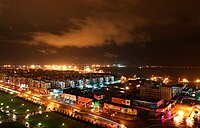
|
Shantou is the main city of the Chaoshan region. It is a port on the South China Sea, and is one of China's Special Economic Zones. Districts: Jinping, Longhu, Haojiang, Chaoyang, Chaonan, Chenghai |
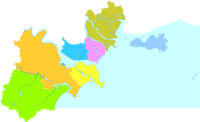
|
| Jieyang 揭阳 |
Pinyin: Jiēyáng Cantonese Yale: Kityèung Peng'im: Gig4-ion5 Pe̍h-ōe-jī: Kiat-iông |
5,877,025 | 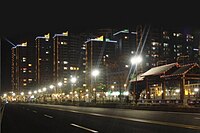
|
Jieyang is the most populous city of the region. It is one of the fastest-growing cities in terms of population. Districts: Rongcheng, Jiedong |

|
| Chaozhou 潮州 |
Pinyin: Cháozhōu Cantonese Yale: Chìujāu Peng'im: Dio5-ziu1 Pe̍h-ōe-jī: Tiô-chiu |
2,669,844 | 
|
Chaozhou is the smallest of the three cities in the Chaoshan region. It is an old town with a large historic and cultural value, which is now undergoing urbanisation. |
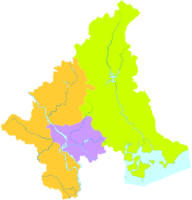
|
In March 2013, a proposal to merge Chaozhou, Jieyang and Shantou cities and upgrade them to vice provincial cities in Guangdong Province was submitted to the National Congress.In March 2014, Chen Jingwei, member of the CPPCC National Committee and vice-chairman of the Federation of Chinese Industry and Commerce, submitted the proposal again in 2013.
General description of nature
Chaoshan is located in the south of Baxiang Mountain, Yinna Mountain, Han River valley and Phoenix Mountain, east and west across the eastern foot of Lotus Mountain to Guangdong-Mian border. Northwest high-southeast low, overall low flat, fertile soil, rich agricultural production. Landforms to the plain-based, mountainous, platform, hilly. Hanjiang, Rongjiang, Lianjiang three rivers, plain area by Hanjiang Delta, Rongjiang Plain, Lianjiang Plain, Huanggang River Plain, Longjiang Plain five parts. It borders Zhao'an and Pingping counties in Fujian Province in the northeast, Meizhou City in the northwest and the South China Sea in the southeast.
Chaoshan area has a long coastline with many excellent ports. Its east from Rao Ping County Dacheng Bay, Meizhou County in the west of the mouth, the total length of more than 500 kilometers. There are 169 large and small islands and 2 groups of islands, including South Penghu and Lemen, and 3 sea lakes. The largest island is South Australia, covering an area of 106.85 square kilometers, with a total coastline of 79 kilometers.
Culture and language
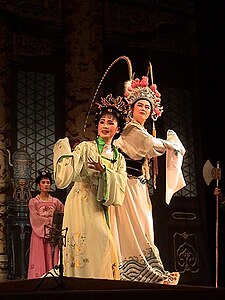
Chaoshan has a culture that is distinct from its neighbours in Guangdong and the rest of China. It does, however, share similarities to the Minnan areas just north of Chaoshan in Fujian province. One of the main reasons is its language, the Chaoshan or Swatow dialect. This variant of Chinese has eight tones, compared to the six tones found in Cantonese and the four to five tones found in Mandarin, which made it one of the most difficult ones to master.[citation needed] Music, opera and Chaozhou cuisine are further characteristics that distinguish Chaoshan people from the rest of Guangdong.
The Chaoshan dialect (潮州話/潮汕話) of Min is considered one of the more conservative Chinese dialects, as it preserves features from ancient Chinese that have been lost in some of the other modern dialects of Chinese.[citation needed] Locals claim Chaoshan dialect is one of the oldest in China.[citation needed] It is spoken by about 10 million people in local Chaoshan and approximately two to five million overseas.[citation needed]
According to historical records, Chaoshan dialect originated in Qin and Han Dynasties, developed in Tang and Song Dynasties, took shape in the late Ming and early Qing Dynasties before forming an independent language system. Its main body is the Central Plains ancient Chinese, mixed with the Min dialect, Wang Shuo once said with a smile: "Qin Shihuang speaks a Chaozhou dialect." The Chaoshan dialect is pronounced in eight tones (four tones in Putonghua). As for the eight notes of Chaozhou, some people once summed up their image as: "Hong Kong police, old and powerless". The oldest surviving dictionary of Chaozhou sounds is "Twenty-Five Tones of Chaoyu" written by Zhang Shizhen, a merchant in Chenghai, late Qing Dynasty.
Chaozhou opera (潮劇) is a traditional art form which has a history of more than 500 years, and it has been performed in over 20 countries and regions.[4] Based on the local folk dances and ballads, Chaozhou opera has formed its own style under the influence of Nanxi opera. Nanxi is one of the oldest Chinese operas that originated in the Song Dynasty. The old form of choral accompaniment still remains its special features. Clowns and females are the most distinctive characters in a Chaozhou opera, and fan-playing and acrobatic skills are more prominent than in other types of performances.[citation needed]
Gongfu tea (工夫茶), the "espresso" of Chinese teas with a formidable kick, which was first consumed back in the Song Dynasty, is still flourishing and remains an important part of social etiquette in Chaozhou.
At the local teahouse, tea service is often accompanied with Chaozhou music (潮州音樂). Chaozhou string music, the gong and drum music, flute music are the traditional musical forms of Chaozhou music. Chaozhou string music is made up of mostly plucked and bowed string instruments, and on some occasions, wind instruments are used. The most characteristic instruments are the rihin (二弦), tihu (提胡) and yahu (all two-stringed bowed lutes), the sanxian, pipa, ruan, guzheng, and yangqin. The number of instruments and performers in the ensemble is flexible and depends on the availability of instruments and musicians to play them - but for an even and balanced texture only one of each instrument is preferred.[citation needed] Chaozhou drum music includes the big drum and gong, the small drum and gong, the dizi set drum and dong and su drum and gong ensembles. The current Chaozhou drum music is said to be similar to the form of the Drum and Wind Music of the Han and Tang Dynasties. Chaozhou guzheng (潮州古筝) is also regarded a major genre of Southern style of Chinese guzheng.[citation needed]
Chaoshan cuisine
Chaoshan cuisine, also known as Chiuchow cuisine, Chaozhou cuisine or Teochew cuisine, originated from the Chaoshan region in the eastern part of China's Guangdong Province, which includes the cities of Chaozhou, Shantou and Jieyang. Relative economic and linguistic isolation (most people do also speak Mandarin) has helped maintain Chaoshan area's local traditions, which has turned into a boon for foodies.[5]
Chaoshan cuisine, similar to Cantonese cooking, is characterized by use of ingredients such as fresh seafood, poultry, galangal, Chinese basil and vegetables.[5] Chaoshan dishes taste fresh, light and natural. There are also unique local sauces such as puning soy sauce, Shantou sweet and spicy sauce, garlic white vinegar sauce and fermented fish sauce. Salty, spicy, sweet or sour, each has its own outstanding flavor.[6] Teochew (also Chaoshan or Chiu Chow or Chaozhou) cooking focuses on restraint and subtlety and avoids heavy seasonings to highlight the freshness of ingredients.[7] The ingredients of Chaoshan dishes usually include white olives, rice noodles, or mandarin oranges.[7] These ingredients often come from the sea in Chaoshan, a hundred miles up the coast from Hong Kong.[7]
The cooking methods of Chaoshan dishes are diversified, including brining, deep-frying, pan-frying, braising, alive marinating, stewing, roasting, smoking, steam stewing, dressing, etc.[6] The most used method among these is brining. Chaoshan brined meat is the signature dish in Chaoshan cuisine. Meat is brined together with rich flavors. Local dishes also use marinated raw seafood, such as colorful flower crabs steeped in a bath of vinegar, salt, chilis and cilantro.[7] The seafood cooked by this way is extremely umami.
Chaoshan has a rich history of farming and drying seaweed, which Westerners might instinctively associate with Korean and Japanese cooking.[7] The ancient Teochew tradition of preparing thinly sliced raw fish was later exported to Japan, becoming known as sashimi.[7]
The most famous culinary method in Chaoshan is marinated broth stew, where poultry (especially local geese) and other meat are slow cooked in a highly flavored broth.[5] This is different from Cantonese food, in which barbecued meat is arguably one of the most representative dishes.
-
Chaoshan seafood hotpot
-
Drunken crabs
-
Chaoshan beef hotpot
Chaoshan Religion
Buddhism
Chaozhou Buddhist schools are: Cao Dongzong[2] Hua Shou faction, Linji Zong[3] Putuo Mountain Associated Hill hermitage faction, Huang Bai Zong[4] Tiger Creek faction. Buddhist groups are: Buddhist Association, Buddhist Jusilin, Yi Shou Mutual Aid Association.
Between the Eastern Jin Dynasty and the Southern and Southern Dynasties[5], there was a Buddhist temple in Haiyang (or Yingzhou), but by the Southern and Sui Dynasties, Haiyang had increased to two, indicating that Buddhism had been introduced into Chaozhou as early as the Eastern Jin Dynasty.
Kaiyuan Temple in Chaozhou[6], one of the four ancient temples in China, was built in the 26th year of Kaiyuan (AD 738) in Tang Dynasty. It is said that its predecessor was "Lifeng Temple" founded during the Sui and Tang Dynasties.
Lingdong Buddhist Institute was founded on October 9, 1933, for Master Cheng Hong, when he taught at the Southern Fujian Buddhist Institute as the director. May 1948 suspended, in October 1991 Chaozhou Kaiyuan Temple Mingsheng, Huiran, Ciyun preparations for re-run. Institute as the director. May 1948 suspended, in October 1991 Chaozhou Kaiyuan Temple Mingsheng, Huiran, Ciyun preparations for re-run.
Taoism
The Chao people believed in Taoist gods, mainly Laojun Li[7], Emperor Jade Emperor, Xuan Tian God (Zhenwu Emperor), Zhang Tianshi and Lu Tung-pin (Lu Zu Xian-shi) and Han Xiang-tzu. There are also folk gods that are directly related to their lives, mainly the kings of Sanshan, Cheng Huang, God of Wealth, the God of Fortune, Tin Hien, the Emperor of Baosheng, the Mother-in-law, and the gods of trade.
Catholicism
Catholicism has been introduced into Chaozhou City for more than 300 years. In the mid-17th century, Portuguese Dominican missionaries began to preach in Chaozhou. In 1724 (the second year of Yongzheng), the capital had a church[disambiguation needed], covering an area of 200 abbot, then destroyed. But there were no permanent priests, and every other year or so, the Dominican priests from Fujian or Portuguese priests from Macao came to visit the ministry. In 1850 (Dao Guang 30 years), French priest Li went on a mission tour to Chaozhou. In the same year, the Holy See issued an encyclical[8], Chaozhou missionary affairs[9], by the French missionary missionary outside Paris. In 1875 (the first year of Kuang Hsu's reign), the French priest Shao came to assist in missionary work, set up a study, and set up a church in the capital. In 1885 (the 11th year of Guangxu), Father Bussek, a French national, applied for permission to build a lobby in the capital, which was built in 1904 (the 30th year of Guangxu) and was named the Blessing Hall of Our Lady.
In 1914, the Catholic Guangdong vicarage area was divided into Guangzhou vicarage area and Chaozhou vicarage area. On August 18, 1915, Chaozhou vicarage area was changed to Shantou vicarage area[10].
Protestantism
In 1848 (the twenty-eighth year of Qingdao Guang), the German Parish Mission and the Swiss Congregation sent the pastor Le Likki to Chao'an Long Lake[11] to preach, but he was not accepted by the local government.
The Presbyterian Church began preaching in Chaozhou City around 1856, then moved to the back alley of the branch office, then moved to Monkey Cave. In 1922, another church was built in Mansu Palace (now Mansu-ri, Changli-ro). In 1924, the church was completed and dedicated. The Presbyterian Church then began developing into townships such as Yixi.
In 1880, the American Baptist Church was introduced to Haiyang County and Huanggang Town and Sanrao Town, and in 1894 (the 20th year of Guangxu's reign), the American priest Jin Shidou built two chaplain's buildings on Bijia Mountain. In 1906, the West Road (now 84 West Road) built a church, named "Book Hall." Later, the lecture hall was converted into a two-story house, renamed "City Hall". In 1948, the Baptist Church began its rural development.
In 1907 (the 33rd year of Guangxu, Qing Dynasty), Rev. Kang and Rev. Mak of Seventh-day Adventist Church came to the city to preach. In the same year, Elder Huang Xi-rong built the Seventh-day Church in Eighteen Qu Lane.
After 1958, the three denominations held a joint worship service at the China Christian Church in Mansu Palace, Changli Road.The church was shocked during the Cultural Revolution, the church was closed and the church members, priests, nuns and priests were persecuted. In 1983, believers of the three denominations united to lead a normal religious life in the former town hall. Pastor Kwak Hak-do presided over the service and renamed the town hall City Hall. On September 25, 1999, the Chaozhou Christian Association held a foundation-laying ceremony for the new church, Heng Ai Church, on Fengyuan Road, Xiangqiao District. On December 24, 2000, "Heng Ai Tang" was completed as the main church of Chaozhou Christian Church. Originally, Zhongdang became a city church where some elderly believers lived in the old city lived religiously.
See also
- Chu Hua Yuan, the area's traditional coming-of-age ceremony
- Lingnan
- Lingnan culture
- Teochew people
- Thai Chinese
References
- ^ James Stuart Olson (1998). An Ethnohistorical Dictionary of China. Greenwood Press. p. 42. ISBN 0-313-28853-4.
- ^ Tian Guang. "Soft Power and Shantou Economic Special Zone Construction : A New Breakthrough Point for Development" (PDF). Na-businesspress.com. Retrieved 2022-01-27.
- ^ "Calls for creation of new SEZ in Shantou - Business". Chinadaily.com.cn.
- ^ Miao, Lei; Wang, Qiuping (2018-05-01). "A Study on the Spread of Chaozhou Opera in Thailand under the Strategy of Maritime Silk Road" (PDF). Journal of Language Teaching and Research. 9 (3): 520. doi:10.17507/jltr.0903.10. ISSN 1798-4769.
- ^ a b c "Chaoshan cuisine: A culinary tour through Chaoshan". Travel.cnn.com. Retrieved 2019-11-07.
- ^ a b "Chaoshan Cuisine / Teochew Cuisine in Chaozhou & Shantou". Travelchinaguide.com. Retrieved 2019-11-21.
- ^ a b c d e f "Chaoshan cuisine gets the spotlight on Netflix's new show, 'Flavorful Origins'". Los Angeles Times. 2019-02-25. Retrieved 2019-11-07.
External links
 Media related to Chaoshan at Wikimedia Commons
Media related to Chaoshan at Wikimedia Commons

